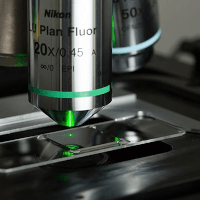RAMAN Spectrometry
RAMAN spectrometry measures the inelastic scattering of monochromatric light in the UV-Vis-NIR range due to changes in the polarization of a molecular bond, and can be used to give information about the vibrational and rotational modes of a molecule. Many substances are active in both FTIR and RAMAN, however RAMAN is relatively insensitive to water, allowing the study of aqueous solutions of biological samples as well as being useful in waste water pollution studies.
RAMAN spectroscopy can be used on solid and liquid samples and the small amount of (or no) sample preparation also gives RAMAN an advantage over many other forms of analysis. Newer RAMAN technologies such as Spatially Offset RAMAN spectroscopy (SORS) allow for analysis through sample containers, making this form of non-destructive analysis very useful in the pharmaceutical and food industries.
Click on the links below to examine these.
